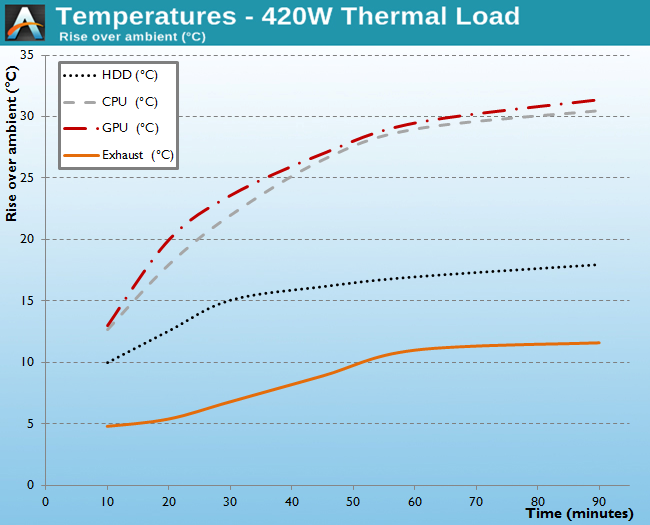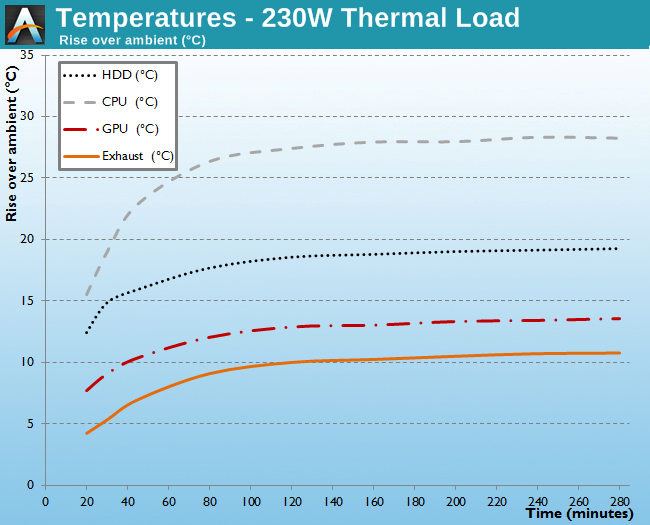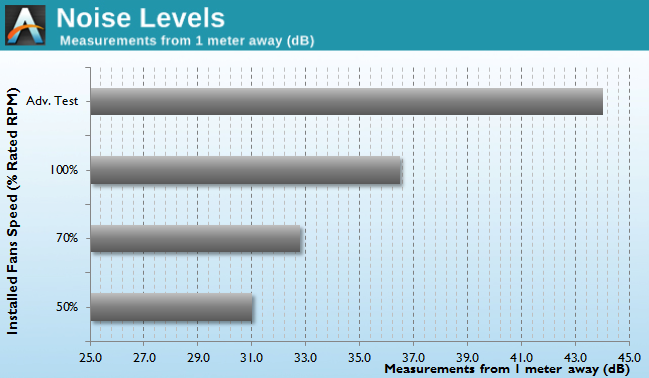Corsair Carbide Air 240 Case Review
by E. Fylladitakis on August 15, 2014 6:00 AM EST- Posted in
- Cases/Cooling/PSUs
- Corsair
- ATX
- Case
- Carbide
Test Setup
Professional testing requires the emulation of real-world situations but with repeatable results; thus, a perfectly controllable test setup and environment are required, especially for comparable results. Testing the thermal performance of any case with a typical real-world setup technically limits the comparability of the results to this setup alone, as an active system interacts with its environment and the change of a single component would alter myriads of variables. For our case reviews, we developed synthetic loads that emulate the thermal output of real systems, but these are passive, steady and quantifiable loads. This allows us to test the thermal capabilities of the case alone, as if it would have to deal with the entire thermal load by itself, regardless of what system an end user might install in it.
Laboratory data loggers are used to monitor the PT100 sensors and control the safety relays, which are fully accessible via our custom software. We have created three such loads, and we'll use the Micro-ATX load for this case. The Micro-ATX version simulates a 180W CPU, 40W VRM, 20W RAM, and 1 × 120W GPU card thermal load. Finally, two 3.5" HDD dummy loads have also been installed, with each of them converting 30W of electrical power to thermal. Note that the total load is generally more important than the individual elements, and the total thermal load of the Micro-ATX test setup is up to 420 Watts. As such, the thermal load is very high and only the best of cases will be able to handle it for more than a few minutes. For comparison purposes, we are also performing a test with a thermal load of 230W by reducing the CPU load to 90W, removing one disk load and using a low-profile, 50W version GFX load.
Thermal testing is performed with all of the case's stock fans operating at maximum speed. Standard noise testing has been performed with a background noise level of 30.4dB(A). Advanced noise testing is also being performed, in order to assess the ability of the case to dampen the noise of the components installed inside it. This includes the installation of two noise-generating sources (strong fans) inside the case, one positioned approximately over the first expansion slot and one over the CPU area, which generate ≈ 44.2 dB(A) when unobstructed. During the advanced noise test, all stock cooling options of the case are disabled.
Results and Discussion
As we expected from a case designed for ventilation, and despite its relatively compact size, the Carbide Air 240 displays exceptional thermal performance, significantly superior to that of the Mini-ITX Obsidian 250D. Although a direct comparison is not really possible, as the GPU load we use to test ATX cases is much higher, it would appear that the Carbide Air 240 has little to be jealous of Midi-ATX cases as well, delivering CPU and HDD temperatures that can easily rival cases such as the XFX Bravo 01 and Corsair's own Obsidian 450D.
The three stock cooling fans of the Carbide Air 240 are fairly weak, but that also has a positive effect on the acoustic performance of the case. With only the stock cooling fans installed, the Carbide Air 240 is a relatively quiet system, which can be made entirely quiet by simply connecting the fans onto the motherboard headers and leaving their speed control up to the BIOS. However, due to its design, the Carbide Air 240 cannot dampen the noise of the components installed inside it. Our testing revealed nearly zero noise-dampening capabilities, which is true of any case with so many openings on all sides.













63 Comments
View All Comments
HisDivineOrder - Sunday, August 17, 2014 - link
They take up too much space for too little gain. That space could be more 3.5" slots or even an open place for a fan.lexluthermiester - Wednesday, August 20, 2014 - link
Yup that's what he said. Wake up before you open your flap-trap.Etern205 - Friday, August 29, 2014 - link
I guess you haven't been old enough or encounter more, to know the nightmare it was to deal with external optical drives when they first arrived. I still remember when I had to use a external optical drive a few times to reinstall the OS on laptops where their internal optical drives had died or those that don't come with one. The problem is they're not that well built and the laptop itself as well as the bios also played a part.So this is what happens.
1. Not all USB ports plays nicely with USB optical drives, some will let it detect, but after a few minutes it mysteriously disconnects and then I had to power off the laptop and power it back on to let it find it again.
2. Some USB ports refuses to even detect any USB optical drives even after I changed to different brands, them USB cables, or even use one of those a internal optical drives connected via a SATA to USB adapter kit.
3. If I was lucky enough to begin the installation, I have to have my fingers crossed hoping the USB optical drive does not crap out during the middle of the installation and if it did, I have to restart the installation. The worst parts is finishing the installation up to 99% and then the USB optical drive craps out, so basically that's like a whole hour or so wasted for nothing.
4. Some laptops and USB optical drives have a mind of its own. they either want to work or don't work. With all these problems and weird behaviors, what used to be a simple install of the OS, has become a day of hell, just to get something that simple to complete, if their internal optical drive was working or it had one in the first place.
While they might have now improved, they had left a bad rep, therefore I still prefer a internal optical drive and cases should comes with at least one 5.25" bay. If you don't see the need to use a internal optical drive, then that 5.25" bay can be used for something else like adding a Hotswap SSD/HDD kit. or a LCD fan controller.
http://www.newegg.com/Product/Product.aspx?Item=N8...
I say Kill USB optical drives with fire and throw them stupid crap built laptops in alone with it.
Refuge - Friday, August 21, 2015 - link
I remember building in the 90's.To think external optical drives today are anything like the external drives of old, I guess you are just too old to build computers today?
Also back then, the simple work around was to take an internal drive, and just set it in the bottom of the case and hook it into the Mobo that way. I think you just lack imagination.
Kevin G - Friday, August 15, 2014 - link
I'll second the idea of additional 3.5" bays behind the motherboard. Also make them hot swap and then the case would be ideal for a DIY NAS or HTPC with redundant storage.lexluthermiester - Wednesday, August 20, 2014 - link
Totally with you!coburn_c - Friday, August 15, 2014 - link
Why do they ruin everything with garish plexy. Case windows should be an add-on option, industry wide.Infernus - Friday, August 15, 2014 - link
I agree, that's the only gripe I have with my 540 (and soon to be 240 when it eventually arrives).On a side note, I don't know why Apple doesn't offer the original NeXT Cube case in mATX/ATX format - I know I would pay good money for it.
notlurking - Friday, August 15, 2014 - link
Apple doesn't even have to do it! The NeXT Cube design patents expired years ago. I don't understand why, despite ten years of everyone saying they want a cube, that no manufacturer makes one. The next cube was 12"x12"x12" with a microATX sized motherboard, 1x3.5" bay and 1x5.25" bay.The 1x3.5" bay is need for SD slot or fan controller. Every laptop and All-in-one PC for the past ten years has had an SD slot yet only LianLi builds an SD slot in their case. The 1x5.25" bay is necessary because someone needs to do the rips that everyone else downloads.
Many people have bought NextCubes and modded them into PC's. I don't have time for modding but I'd pay for a 13"x13"x13" cube case.
The Carbide Air is so close to perfect, but I won't buy a 15.75" deep case that doesn't have a 5.25" bay.
zlandar - Friday, August 15, 2014 - link
The 12.4" height is too large to fit most entertainment consoles. My console has two fairly large shelves and the max height is 8.5". Not a ding since the author mentioned the case was not specifically designed for HTPC use but something to consider for people considering it.